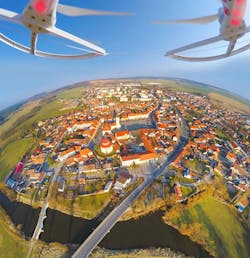Droning on: More on Use of Unmanned Aircraft Systems in Construction
Following my July 21, 2015, blog post, “Drones on Building Job Sites,” I was asked to co-present a webinar titled “Opportunities and Pitfalls of Using Drones on Your Construction Site.” My portion of the program, which was presented in January, focused on the need for construction-site photography, how construction-site photography can be provided with drones, and some of the legal and practical considerations. HVAC professionals—like others in construction-related fields—use photographs to provide permanent, indisputable evidence that project requirements have been met. Our firm, in assisting clients with green-building certification, often recommends illustrations of pre-construction site conditions—using either photographs or satellite imagery—and photographic evidence that best-practice installation procedures were followed during construction. Because many of these photographic requirements can be met with drones, we have been closely following the use of drones for nearly two years.
The most recent development was a March 10 hearing of the Senate Committee on Small Business and Entrepreneurship to consider the economic impact of easing government restrictions on the use of commercial drones. According to testimony presented during that hearing, drones are used in 35 industries accounting for more than a million jobs and some $900 billion in economic contribution in the United States. Federal law prohibits the use of drones, officially known as unmanned aircraft systems (UAS), for commercial purposes without a Section 333 exemption from the Federal Aviation Administration (FAA). As of August 2015, the FAA has granted more than 1,000 of these exemptions, permitting drone operation at or below 200 ft, except in restricted airspace, close to airports, and in other prohibited areas.
Another Senate committee, the Senate Committee on Commerce, Science and Transportation, joined with the House of Representatives to grant an extension of the FAA’s funding, which would have expired on March 31, through July. Originally, the Senate favored a long-term extension that was to have included several new amendments related to drones. It seems clear the Senate—and the FAA—would like to make commercial-drone use available to the business community while still protecting the public.
Commercial-drone use is not, of course, limited to construction-site photography. Walmart, Amazon, Google, Domino’s, and DHL all have expressed interest in using drones for product delivery. That's strong economic incentive to push the commercial-drone industry forward, which would benefit our industry. There are some practical and legal considerations: The cost of equipment can be expensive, drone piloting requires skill and training, and, regardless of the outcome of the FAA's rule making, there certainly still will be privacy considerations.
What does all of this mean for our industry? Perhaps coming soon to your job site: photographs, revised plans, and delivery of that special-order evaporator fan motor ...
About the Author
Larry Clark
A member of HPAC Engineering’s Editorial Advisory Board, Lawrence (Larry) Clark, QCxP, GGP, LEED AP+, is principal of Sustainable Performance Solutions LLC, a South Florida-based engineering firm focused on energy and sustainability consulting. He has more than two dozen published articles on HVAC- and energy-related topics to his credit and frequently lectures on green-building best practices, central-energy-plant optimization, and demand-controlled ventilation.

